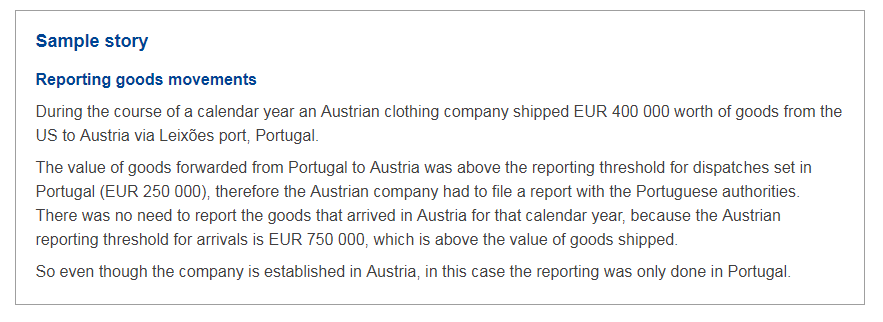Importing/exporting within the EU
As a business trading in Europe, you can benefit from the EU Single Market and also from certain trade arrangements with other European countries. This means most goods can move freely within this territory without any extra costs or quantitative restrictions. This is known as free movement of goods. However, certain goods such as excise goods and chemicals are subject to additional rules. You also have different VAT obligations depending on what you sell, to whom and where the goods are transported to.
BREXIT: the United Kingdom is no longer a member country of the European Union. However, the UK and EU are in a transition period until at least 31 December 2020. During that period, all EU laws continue to apply in the UK. This includes product rules and regulations, customs formalities and reporting obligations.
Customs formalities must be completed when goods are imported or exported between the EU and any non-EU country (including those benefiting from the free movement of goods, in this case: the European Economic Area, Switzerland, Turkey, Andorra and San Marino).
EU product rules and regulations
Prior to bringing goods onto the EU market, you must ensure that your products meet the EU requirements to protect human and animal health, the environment and consumers rights. This could be rules and specifications that are harmonised within the EU or those managed by each EU country but recognised by the EU; known as mutual recognition. You can read more about this on the product rules and specifications topic.
There is no difference between customers anywhere in the EU
While you are free to define your general terms and conditions of sale, including limitations on delivery, all your customers based in the EU must have the same access to goods as your local customers.
If you offer a special price, promotion or sales conditions, these should be accessible to all your customers irrespective of which EU country they are located in, their nationality, place of residence or business location.
The rules apply to online and offline transactions as long as the sales are to the end user (an individual or business that doesn't have the intention to re-sell, transform, process, rent or subcontract their purchases).
Access to online interfaces
Your customers must be able to access any version of your website they want, for example, if they type in the Spanish URL of your website and they are connecting from Italy they shouldn't automatically be re-directed to the Italian version. They must give you their consent before you redirect them and they have the right to withdraw their consent at any time.
Sales of products without delivery
If you offer a collection service you must ensure that customers based in EU countries where you don't offer a delivery service have the right to order products from your website, and arrange their own delivery or pick up.
Reporting goods movements
If you export and/or import within the EU of more than a certain value, you will have to provide a statistical report on your intra-EU trade flows.
The thresholds above which you must report are set every year by each of the EU countries (usually in the last quarter) and they apply for the whole of the following calendar year. Separate thresholds exist (that might differ) for exports (dispatches) and imports (arrivals).
Where does your reporting obligation start?
'Your' EU country sets a threshold which is applicable for a given calendar year.
If your imports/exports of the previous year exceeded that threshold then you must report from January of this given year onwards.
Example: 'your' EU country sets the import threshold for 2019 to EUR 100 000. If, in 2018 you imported more than EUR 100 000, you must report from January 2019 onwards.
Your previous year's imports/exports did not exceed the threshold, but during the course of the current year they do so, you will then have to start reporting from the month in which the threshold was exceeded.
Example: 'your' EU country has set the import threshold for 2018 to EUR 100 000. From January to June 2018 your accumulated imports amounted to EUR 90 000. In July, you import goods of another EUR 15 000. As you have exceeded the threshold in July 2018 you must report from this month onwards. Your first Intrastat declaration would then relate to the July imports of EUR 15 000.
You may have to report good movements to or from EU countries where your company is not based.

Who has to report?
Businesses and private individuals which are registered for VAT and who dispatch or receive goods — if the dispatches or arrivals exceed the respective yearly threshold.
You may ask a specialised company to represent you and to provide the report on your behalf
When do you have to report?
At least once every month on your trade flows for the previous month.
The deadline for submission is set by the relevant national authority in each EU country.
Which trade flows must be reported?
Physical movements of goods from the member state of dispatch to the member state of arrival (and vice versa).
If you have authorisation for the customs procedure of inward processing - and the unprocessed/processed goods move between EU countries - you are obliged to report these movements.
Note: If you only offer cross-border services that don't include any cross-border movement of goods, there is no need to report under the Intrastat system.
What data to report?
Your monthly Intrastat reports should include the following:
your VAT ID number
the period (month) you are reporting on
the direction of the trade flow: dispatch or arrival
the 8-digit product code of the Combined Nomenclature (CN) (The CN is published each year in the Official Journal of the EU)
the code of the EU country of dispatch/destination
the value of the goods - excluding VAT and excise duties
(If the value relates to processing activities, you would need to obtain the value of the processed goods, and then work out the value of the unprocessed goods plus any value added during the processing, e.g. for materials and wages).
Example: you have a contract to coat metal tubes which are sent to you from another Member State. The value to report for your imports would be the value of the unprocessed tubes; for your exports you would need to report the value of the processed, coated tubes (which would then consist of the value of the unprocessed tubes plus any additional costs: service charges and materials).
the quantity of goods in net mass (gross weight minus the weight of the packaging)
the unit of measurement according to CN (for example litre, number of items. square metres)
the code for the nature of transaction (which identifies the buying, selling or processing activity).
You may also be required to provide additional information such as delivery terms as specified in your contractual arrangement (e.g. EXW, CIF, FOB) or the mode of transport (e.g. sea/road/rail transport).
National authorities offer tools to help businesses meet their Intrastat reporting obligations.
The article is originated from europa.eu.

 Login
Login Login
Login CCCEU and Gunnercooke Successfully Host Webinar on CSDDD and FLR Compliance to Guide Chinese Businesses
CCCEU and Gunnercooke Successfully Host Webinar on CSDDD and FLR Compliance to Guide Chinese Businesses Cultivating responsible China-EU business leaders essential to tackling global challenges
Cultivating responsible China-EU business leaders essential to tackling global challenges



